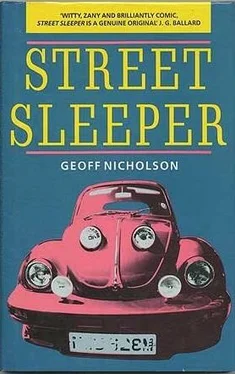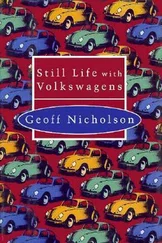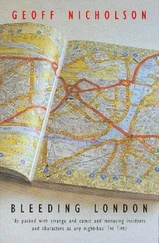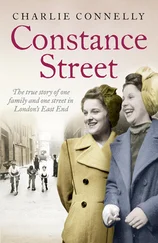Geoff Nicholson - Street Sleeper
Здесь есть возможность читать онлайн «Geoff Nicholson - Street Sleeper» весь текст электронной книги совершенно бесплатно (целиком полную версию без сокращений). В некоторых случаях можно слушать аудио, скачать через торрент в формате fb2 и присутствует краткое содержание. Год выпуска: 1987, Издательство: Quartet Books, Жанр: Современная проза, на английском языке. Описание произведения, (предисловие) а так же отзывы посетителей доступны на портале библиотеки ЛибКат.
- Название:Street Sleeper
- Автор:
- Издательство:Quartet Books
- Жанр:
- Год:1987
- ISBN:нет данных
- Рейтинг книги:3 / 5. Голосов: 1
-
Избранное:Добавить в избранное
- Отзывы:
-
Ваша оценка:
- 60
- 1
- 2
- 3
- 4
- 5
Street Sleeper: краткое содержание, описание и аннотация
Предлагаем к чтению аннотацию, описание, краткое содержание или предисловие (зависит от того, что написал сам автор книги «Street Sleeper»). Если вы не нашли необходимую информацию о книге — напишите в комментариях, мы постараемся отыскать её.
Street Sleeper — читать онлайн бесплатно полную книгу (весь текст) целиком
Ниже представлен текст книги, разбитый по страницам. Система сохранения места последней прочитанной страницы, позволяет с удобством читать онлайн бесплатно книгу «Street Sleeper», без необходимости каждый раз заново искать на чём Вы остановились. Поставьте закладку, и сможете в любой момент перейти на страницу, на которой закончили чтение.
Интервал:
Закладка:
‘He got the message,’ Ishmael said.
♦
Saturday 16 June 1973, Malcolm Buchanan ‘drives’ his Beetle from the Isle of Man to England. He knows that the Beetle is famous for being waterproof and airtight, that it pays to open the window before trying to close the door, but this is a special sea-going version. Malcolm manages to travel thirty-two miles in just over seven hours, though he runs out of fuel just four hundred yards from the Cumberland coast. Now there’s an existential image for you — a man alone, drifting across the sea, powerless to control his fate, in a floating Volkswagen Beetle. The car at last drifts ashore at St Bees Head. Malcolm tells the press he did it all for charity.
♦
The Plan swept into its final mobile phase. Four Beetles stood outside Fox’s Farm, but these were not ordinary Beetles. Fat Les and Davey had performed a transformation or two.
The windscreens were bullet-proof, the cars had monstrous all-terrain tyres, bumpers made out of steel tubing, hub-caps featuring Boadicea-style spikes, engines so big they burst from their compartments. Sheets of ugly, tattered metal had been welded on here and there as protective shields. They were ugly, deformed and dangerous. Mary had painted them with symbols — mandalas, eyes in pyramids, crescents, pentacles, yin and yang signs, swastikas — holy symbols.
And there was a fifth Beetle. It was Enlightenment and it was changed. Every inch of it was now black. Every piece of chrome had been removed. Bumpers, door handles, wheel centres, exhaust pipes, were all matt black. The headlights had black covers. The windows were smoked glass. Enlightenment sat low and vicious on fat tyres.
Ishmael sat inside, Marilyn beside him. It felt like home.
Fat Les drove the first of the other Beetles, Davey another, the Norton twins another, and Harold the former bank manager the fourth. Other members of the commune were scattered among the passenger seats, front and rear. They wore scraps of leather and animal skins. Their bodies and faces were painted, some heads were shaved. They carried axes and picks, claw hammers, slingshots and Bowie knives.
They looked quite decorative.
Five engines burst into violent life. Ishmael led the grim procession out from Fox’s Farm, out on to the roads, God’s own country.
♦
At his home in Yorkshire, nearly forty years after his time at Wolfsburg, Ivan Hirst straightens his cravat, lights his pipe, buttons his cardigan, and dusts his collection of model Beetles. It is probably the world’s best collection and contains just four items.
He had the idea of a promotional toy or paperweight in the shape of the car as early as 1946, thus he was surely the first to confirm the Volkswagen’s status as objet d’art . The first attempt at casting in aluminium was very crude and Hirst found it unacceptable — today it looks like a bar of soap in the shape of a Beetle, a bar that has been used several times. The second attempt was far more successful — wheels, doors and windows are clearly described in the aluminium. He kept an example of each of these two states of model on his desk until he left Wolfsburg in 1949.
♦
It was an easy journey. They drove in stately procession with Ishmael at the head. They drove with due care and attention. They obeyed speed limits. They signalled clearly and in good time. They had consideration for other road users. They did not want to draw attention to themselves.
Two hours later they approached Crockenfield. They were ready. They drove along Hawk’s Lane. They looked for ambushes. They looked for Range Rovers. They saw nothing.
Then they saw ‘Sorrento’. They sounded their horns — five notes that refused to harmonize. They saw the wagon wheel gates. The gates were open. Ishmael slowed Enlightenment down to a crawl and drove into the grounds. The four other Beetles followed. They were ready for traps. They were ready to fight. They were as ready as they ever would be, but they found nothing.
There were no cars parked in front of the house. There was nobody at any of the windows. There was no servant woman telling them they couldn’t park there.
They parked. They sat. They waited. They kept their engines running and their horns blaring. It seemed silly after a while. Ishmael turned off his engine. He stopped sounding his horn. He wound down his smoked window.
‘Supposing they held a war and nobody came,’ said Marilyn.
Ishmael opened his door. He stepped out. His torn blue leather creaked in the warm, still afternoon. He felt scared, yet he felt ready. He had three days’ growth of beard. He looked the part.
He walked to the front door and rang the bell. Nobody answered. He wasn’t surprised. He turned the door handle. It wasn’t locked.
He looked back at the other Beetles. Doors were now opening, people were getting out. Marilyn and John the Hippy and Fat Les walked towards the house.
‘It’s got to be a trap hasn’t it?’ said John the Hippy.
Ishmael still didn’t know. They entered the house. It was still and silent and nicely furnished. In the sitting room Marilyn asked whether anyone would like a drink from her father’s cocktail cabinet. They declined.
They searched the house. It was empty. It was ghostly, like a show house, inhuman and unlived-in. They sat in the kitchen. They felt uncomfortable. Other road warriors entered — Davey and Harold the former bank manager and Tina and Eric the tie-wearer and Caroline with the nose-stud and Mary the artist. They made cups of coffee. They tried to make themselves at home. They were not sure whether they were experiencing victory or defeat.
Should they loot and destroy the house? Should they just go home? Where was home for Ishmael now?
‘We could set up a squat, I suppose,’ said Eric the tie-wearer.
‘It reminds me of one time I went to Margate,’ said Fat Les. ‘The fuzz had got the whole place carved up. We never even got a look at the rockers. I didn’t have a decent bit of bother all weekend.’
♦
Ivan Hirst also owns a unique model of a Beetle-based Reichspost truck, and a one-tenth scale saloon, just like one Adolf Hitler is photographed holding, but this one comes from Heinz Nordhoff. Nordhoff would gladly have given Hirst an actual Beetle cabriolet, but Hirst’s military position prevented him from accepting.
So Hirst has his models to dust, his spoils of war. They are a better way of remembering than most. They speak of creation and of rebuilding. History resides in them as much as in scars, in tattooed skins, in ruined lives and cities, in documentary photographs that need constant reinterpretation.
Today Ivan Hirst drives a BMW.
♦
The Norton twins were standing outside the back door, keeping the garden watched. Suddenly they moved very quickly and entered the house. Ishmael looked out of the kitchen window. There were ten or a dozen men in tweeds, advancing through the herbaceous borders with shotguns.
Suddenly there was a knock on the front door.
‘Do we answer it?’ Tina asked.
‘Of course we do,’ Ishmael said. ‘It’s quite usual for opposing war lords to hurl a few insults at each other prior to the fray.’
He went to the front door. Harold the former bank manager opened the door for him. He was ready for a confrontation with Marilyn’s father, with the devil himself if it came to that. But even so he was surprised to find a uniformed police constable on the doorstep.
‘Hello sir,’ the policeman said. ‘My name’s Constable Peterson and I just happened to be passing when I couldn’t help noticing those rather unusual motors parked outside. We’re having a little bit of a campaign in Crockenfield right now and unless I’m very much mistaken each of those cars is failing to display a valid tax disc. I trust you do have tax, sir, and I’d also be very much obliged to see your driver’s licence and a current MOT certificate, sir.’
Читать дальшеИнтервал:
Закладка:
Похожие книги на «Street Sleeper»
Представляем Вашему вниманию похожие книги на «Street Sleeper» списком для выбора. Мы отобрали схожую по названию и смыслу литературу в надежде предоставить читателям больше вариантов отыскать новые, интересные, ещё непрочитанные произведения.
Обсуждение, отзывы о книге «Street Sleeper» и просто собственные мнения читателей. Оставьте ваши комментарии, напишите, что Вы думаете о произведении, его смысле или главных героях. Укажите что конкретно понравилось, а что нет, и почему Вы так считаете.












